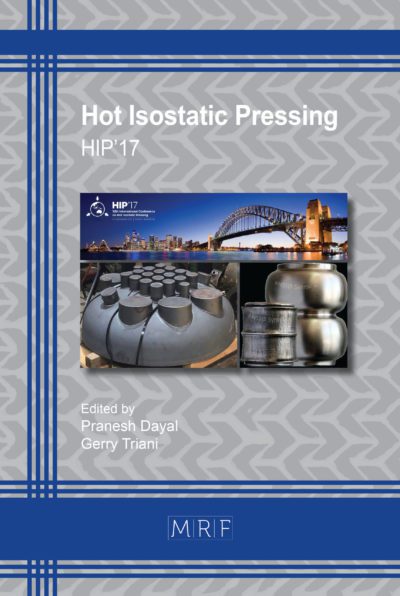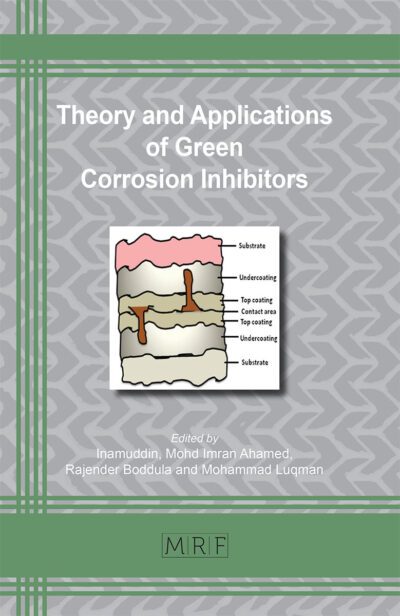Modeling of surface hardening in burnishing process
TEIMOURI Reza, GRABOWSKI Marcin, SKOCZYPIEC Sebastian
download PDFAbstract. In the present paper, a multiphysic model was developed to identify the underlying mechanism of surface layer hardening in burnishing of stainless steel 304. The mechanic of burnishing process was firstly modeled to obtain deformation parameters i.e. strain and strain rate by incremental plasticity. Then the strengthening mechanisms were identified association of constitutive equations regarding twinning-induced hardening and phase change. It was found that the twining-induced hardening has greatest contribution in strengthening the surface layer. Moreover, among the process parameters, the burnishing depth has greatest effect on hardness magnitude and corresponding depth.
Keywords
Burnishing, Twining-Induced Hardening, Phase Change, Simulation
Published online 4/19/2023, 12 pages
Copyright © 2023 by the author(s)
Published under license by Materials Research Forum LLC., Millersville PA, USA
Citation: TEIMOURI Reza, GRABOWSKI Marcin, SKOCZYPIEC Sebastian, Modeling of surface hardening in burnishing process, Materials Research Proceedings, Vol. 28, pp 1223-1234, 2023
DOI: https://doi.org/10.21741/9781644902479-133
The article was published as article 133 of the book Material Forming
![]() Content from this work may be used under the terms of the Creative Commons Attribution 3.0 license. Any further distribution of this work must maintain attribution to the author(s) and the title of the work, journal citation and DOI.
Content from this work may be used under the terms of the Creative Commons Attribution 3.0 license. Any further distribution of this work must maintain attribution to the author(s) and the title of the work, journal citation and DOI.
References
[1] S. Attabi, A. Himour, L. Laouar, A. Motallebzadeh, Mechanical and wear behaviors of 316L stainless steel after ball burnishing treatment, J. Mat. Res. Tech. 15 (2021) 3255-3267. https://doi.org/10.1016/j.jmrt.2021.09.081
[2] Z.Y. Zhou, G.L. Yu, Q.Y. Zheng, G.Z. Ma, S.B. Ye, C. Ding, Z.Y. Piao, Wear behavior of 7075-aluminum after ultrasonic-assisted surface burnishing, J. Manuf. Process. 51 (2020) 1-9. https://doi.org/10.1016/j.jmapro.2020.01.026
[3] Y. Hua, Z. Liu, B. Wang, X. Hou, Surface modification through combination of finish turning with low plasticity burnishing and its effect on fatigue performance for Inconel 718, Surf. Coat. Technol. 375 (2019) 508-517. https://doi.org/10.1016/j.surfcoat.2019.07.057
[4] B. Starman, H. Hallberg, M. Wallin, M. Ristinmaa, M. Halilovič, Differences in phase transformation in laser peened and shot peened 304 austenitic steel, Int. J. Mech. Sci. 176 (2020) 105535. https://doi.org/10.1016/j.ijmecsci.2020.105535
[5] S.J. Lainé, K.M. Knowles, P.J. Doorbar, R.D. Cutts, D. Rugg, Microstructural characterisation of metallic shot peened and laser shock peened Ti–6Al–4V, Acta Mater. 123 (2017) 350-361. https://doi.org/10.1016/j.actamat.2016.10.044
[6] S. Rinaldi, D. Umbrello, S.N. Melkote, Modelling the effects of twinning and dislocation induced strengthening in orthogonal micro and macro cutting of commercially pure titanium, Int. J. Mech. Sci. 190 (2021) 106045. https://doi.org/10.1016/j.ijmecsci.2020.106045
[7] X.L. Gao, X.N. Jing, G. Subhash, Two new expanding cavity models for indentation deformations of elastic strain-hardening materials, Int. J. Solid Struct. 43 (2006) 2193-2208. https://doi.org/10.1016/j.ijsolstr.2005.03.062
[8] R. Teimouri, M. Grabowski, R. Bogucki, Ł. Ślusarczyk, S. Skoczypiec, Modeling of strengthening mechanisms of surface layers in burnishing process, Mater. Des. 223 (2022) 111114. https://doi.org/10.1016/j.matdes.2022.111114
[9] D.L. McDowell, G.J. Moyar, Effects of non-linear kinematic hardening on plastic deformation and residual stresses in rolling line contact, Wear 144 (1991) 19-37. https://doi.org/10.1016/0043-1648(91)90004-E
[10] K.L. Johnson, K.L. Johnson, Contact mechanics, Cambridge university press, 1987.
[11] Y. Liu, L. Wang, D. Wang, Finite element modeling of ultrasonic surface rolling process, J. Mater. Process. Technol. 211 (2011) 2106-2113. https://doi.org/10.1016/j.jmatprotec.2011.07.009
[12] F. Liu, W.J. Dan, W.G. Zhang, Strain hardening model of twinning induced plasticity steel at different temperatures, Mater. Des. 65 (2015) 737-742. https://doi.org/10.1016/j.matdes.2014.10.008
[13] G. Dini, R. Ueji, A. Najafizadeh, S.M. Monir-Vaghefi, Flow stress analysis of TWIP steel via the XRD measurement of dislocation density, Mater. Sci. Eng. A, 527 (2010) 2759-2763. https://doi.org/10.1016/j.matdes.2014.10.008
[14] W.J. Dan, W.G. Zhang, S.H. Li, Z.Q. Lin, A model for strain-induced martensitic transformation of TRIP steel with strain rate, Comput. Mater. Sci. 40 (2007) 101-107. https://doi.org/10.1016/j.commatsci.2006.11.006
[15] W. Zhang, X. Wang, Y. Hu, S.Wang, Predictive modelling of microstructure changes, micro-hardness and residual stress in machining of 304 austenitic stainless steel, Int. J. Mach. Tool. Manuf. 130 (2018) 36-48. https://doi.org/10.1016/j.ijmachtools.2018.03.008

































